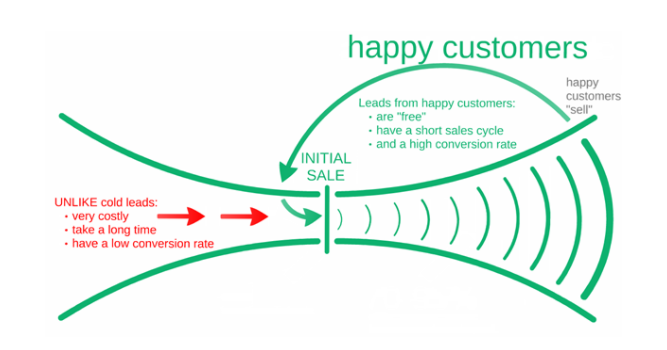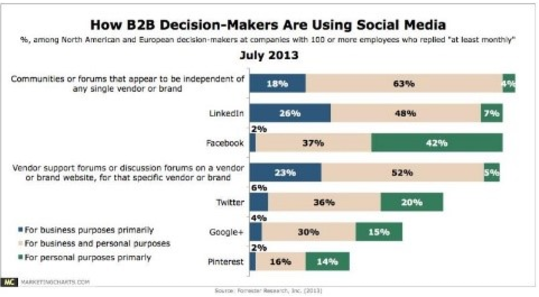Whether you’re creating a web app or a mobile app, there’s plenty of room in the B2B space for apps that solve the problems of business owners and managers.
In some respects, creating an enterprise application is a better model. Your customers are willing to spend money to simplify their process and save time, and they have revenue coming in the door to pay for your product.
But once you’ve built your product (or at least an early version of it), how do you market it? How do you put it in the hands of the right people?
B2B marketing is actually simple. Not easy, but simple. It requires constant product and customer development, creating supporting content, and targeting the right people.
Let’s dive in!
Continue iterating
No amount of marketing will make a poor product successful. Similarly, great products market themselves.
Jordan Stolper, CEO of StoryDesk, tells DMN: “The greatest misconception of app development is that once the software is built, the development ends.”
His point is that software should be continuously refined. You’re bound to make some mistakes. You need to monitor your analytics and speak with your customers to find ways to improve the application. What could be better? What should be removed? What new features should be added?
There are a million ways to iterate on your product. You probably have a million ideas on how to improve the product already. It’s not hard to come up insights. The trick is to prioritize your development (and avoid overdevelopment).
Alex Adamopoulos, founder and CEO of Emergn, believes that “one of the biggest differentiators between companies that thrive and those that fail is the ability to prioritize effectively.” (His article explains nine prioritization techniques, so check it out.)
This is important to keep in mind because many application owners fail to budget for ongoing development. They count their pennies right up until the app is published and wait for results.
Great products are shared organically. If your application is useful and performs well, your B2B customers will spread word of your tool throughout their industry in the spirit of making their friends and colleagues lives easier.
Focus on customer success
Your customers are looking for a solution to a problem. If they don’t realize value with your product (even due to their poor use), they’ll look elsewhere. And you can’t grow if you can’t retain your current customers.
Customer success is the practice of helping your customers find that value. Like product iteration, it helps you create a better application that markets itself. This is critical if you sell a monthly subscription SaaS.
This visual from For Entrepreneurs shows how happy customers send more leads into your sales pipeline. These leads are warmer and move through your sales process faster than typical leads.

The goal of a customer success manager is to onboard your users (not in a technical sense, but in a moment of first value sense) and make sure the product is continually serving their goals. Over time, this doesn’t just make the customer like your product – it makes them dependent on your product.
“Sales are important, but they shouldn’t be your focus when you need your current customers to pay you next month and every month thereafter,” says customer success consultant Nils Vinje. “Sales only begin the relationship. Customer success maintains the relationship for the long haul.”
Content, content, content
Content is one of the most effective ways to generate leads. Content on your website stays around forever, drawing traffic and either sending visitors to your sales pages or converting them to email subscribers (who are later sold on the product).
Content is especially useful in a B2B climate because people are constantly looking for solutions to make their jobs easier, complete difficult tasks, get more done in less time, and build automation into their process.
Ideally, your content should be the beginning of a marketing funnel that flows like this:
- Content collects traffic.
- Traffic joins your email list (now they are leads).
- Leads are nurtured with additional content (perhaps a drip campaign that solves a particular problem or regular blog posts) over time.
- Leads are targeted for sales.
For best results, segment your list as best you can base on characteristics that matter to your business, such as industry, company size, workflow, current solution, revenue, etc.
For instance, you might find that there are two types of people within your customers’ organizations who approach you: developers and project managers. A person who signed up in a blog post about high-level project planning would be tagged as “project manager.” You could send them targeted content and links to landing pages and sales pages that are relevant to their job.
If you want to see some great examples of content marketing, check out this article: 4 Apps Nailing Content Marketing (And How You Can Too)
Make a few videos
According to Google, 70% of B2B product buyers watch videos throughout the purchase journey. That claim and more are backed up in Tubular Insights’ 2015 B2B Video Content Marketing Survey:
- 96% of B2B organizations create video content
- 73% say video has positively impacted their marketing results
- 41% plan to increase spending on video marketing in 2015
It’s also worth noting that Google’s search algorithm favors video content. Websites with videos see a 40% increase in traffic to pages with videos.
B2B marketing agency KoMarketing explains the value of video content well: “Video brings an immediacy, digestibility, context, and personality that even the most clever of text-based business content struggles to achieve… at least in our instant gratification, device-ruled world.”
A great video should tell a story. It should be intriguing, but informative (remember, you aren’t entertaining). It uses a logical flow that starts by acknowledging the visitor’s problem, positioning the product as a solution, and then compels the viewer to take action.
Most importantly, a video should feel genuine. The viewer should feel like you want to partner with them to solve the problem, not just transfer money from their pocket to yours.
Prospect hunting
Depending on your niche, mass marketing techniques might not be effective. If you’re selling a scheduling tool for dentist offices (but only ones large enough to afford it), you don’t have time for content or word-of-mouth to spread.
You have to get on the phone and sell. (Well, maybe by email.)
But first, you need a list of prospects who fit your ideal customer profile. (If you haven’t built a customer profile, use this link.)
First, start with social media. With 400 million members, LinkedIn has a tremendous pool of leads. 80.3% of all B2B leads generated through social media came from the social platform.

LinkedIn’s advanced search and Sales Navigator are excellent tools to find and approach people. Send personalized messaging that doesn’t sound like a template. Speak about benefits, not features. Wait a few days, then follow up.
You should also dive into some LinkedIn groups that relate to your business and industry. Engage with people regularly, but don’t be salesy. When you spot someone you can help, target them for selling.
However, if you find LinkedIn to be a little limited (you can’t send more than 160 InMails a month), a service like Findthat.email Chrome Extension can give you some extra air supply by allowing you to search for email addresses on a specific profile or an entire Linkedin search with one click.
After exhausting LinkedIn, try a lead finding tool like any one of these:
- LeadFuze
- Prospect.io
- LimeLeads
- Salesforce
Finally, browse Quora for questions that relate to the problem you solve (not your product). When someone asks a question, you can swoop in and answer it, then reach out for a sale.
Final thoughts
Here’s one final piece of advice: Listen to your customers. You need to know the precise problems they deal with every day and where they are searching for those solutions.
Speak to the people who are already paying for your product. Learn as much as you can from them. How do they prefer to use your product? Which features are necessary? What would make their lives easier? How do previous solutions compare?
Once you know what you customers (and potential customers) need and prefer, your marketing strategy will clarify.
When you’re ready to discuss your project, contact us.
